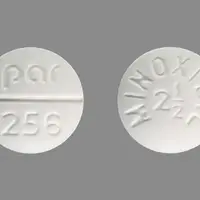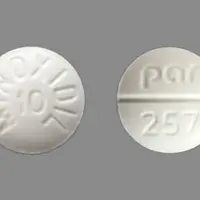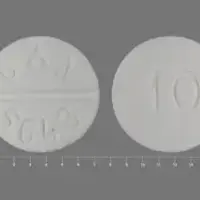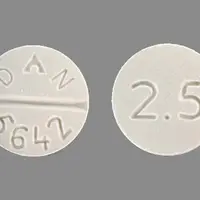Generic name: medically reviewed
Availability: Prescription only
Pregnancy & Lactation: Risk data available
What is Minoxidil (systemic) (monograph)?
Warning
-
Risk of developing potentially serious cardiac effects. (See Cardiovascular Effects under Cautions.) Pericardial effusion, progressing to tamponade may occur and angina pectoris may be exacerbated. Reserve for hypertensive patients who do not respond to maximum therapeutic doses of a diuretic and 2 other antihypertensive agents.
-
In animal studies, minoxidil caused myocardial lesions and other adverse cardiac effects.
-
Administer under close supervision, usually concomitantly with a β-adrenergic blocking agent (β-blocker) and a diuretic, usually a loop diuretic, to prevent adverse effects.
-
Hospitalize and monitor patients with malignant hypertension or those already receiving concomitant guanethidine therapy to prevent too rapid or severe orthostatic decreases in BP.
Introduction
Vasodilating agent.
Uses for Minoxidil (Systemic)
Hypertension
Management of severe symptomatic hypertension or hypertension associated with end-organ damage in patients with uncontrolled hypertension not manageable with maximal therapeutic dosages of a diuretic and 2 other antihypertensive agents.
Not recommended for mild or moderate hypertension or severe hypertension controllable with other drugs.
Not for initial management of hypertension according to current guidelines for the management of hypertension in adults, but may be used as add-on therapy if BP not adequately controlled with the recommended antihypertensive drug classes (i.e., ACE inhibitors, angiotensin II receptor antagonists, calcium-channel blockers, thiazide diuretics).
May be used in combination with other antihypertensive therapies (e.g., a diuretic and a β-blocker, an ACE inhibitor, a calcium-channel blocking agent, and/or an angiotensin II receptor antagonist).
Individualize choice of therapy; consider patient characteristics (e.g., age, ethnicity/race, comorbidities, cardiovascular risk) as well as drug-related factors (e.g., ease of administration, availability, adverse effects, cost).
A 2017 ACC/AHA multidisciplinary hypertension guideline classifies BP in adults into 4 categories: normal, elevated, stage 1 hypertension, and stage 2 hypertension. (See Table 1.)
Source: Whelton PK, Carey RM, Aronow WS et al. 2017 ACC/AHA/AAPA/ABC/ACPM/AGS/APhA/ASH/ASPC/NMA/PCNA guideline for the prevention, detection, evaluation, and management of high blood pressure in adults: a report of the American College of Cardiology/American Heart Association Task Force on Clinical Practice Guidelines. Hypertension. 2018;71:e13-115.
Individuals with SBP and DBP in 2 different categories (e.g., elevated SBP and normal DBP) should be designated as being in the higher BP category (i.e., elevated BP).
|
Category |
SBP (mm Hg) |
DBP (mm Hg) |
|
|---|---|---|---|
|
Normal |
<120 |
and |
<80 |
|
Elevated |
120–129 |
and |
<80 |
|
Hypertension, Stage 1 |
130–139 |
or |
80–89 |
|
Hypertension, Stage 2 |
≥140 |
or |
≥90 |
The goal of hypertension management and prevention is to achieve and maintain optimal control of BP. However, the BP thresholds used to define hypertension, the optimum BP threshold at which to initiate antihypertensive drug therapy, and the ideal target BP values remain controversial.
The 2017 ACC/AHA hypertension guideline generally recommends a target BP goal (i.e., BP to achieve with drug therapy and/or nonpharmacologic intervention) of <130/80 mm Hg in all adults regardless of comorbidities or level of atherosclerotic cardiovascular disease (ASCVD) risk. In addition, an SBP goal of <130 mm Hg generally is recommended for noninstitutionalized ambulatory patients ≥65 years of age with an average SBP of ≥130 mm Hg. These BP goals are based upon clinical studies demonstrating continuing reduction of cardiovascular risk at progressively lower levels of SBP.
Other hypertension guidelines generally have based target BP goals on age and comorbidities. Guidelines such as those issued by the JNC 8 expert panel generally have targeted a BP goal of <140/90 mm Hg regardless of cardiovascular risk, and have used higher BP thresholds and target BPs in elderly patients compared with those recommended by the 2017 ACC/AHA hypertension guideline.
Some clinicians continue to support previous target BPs recommended by JNC 8 due to concerns about the lack of generalizability of data from some clinical trials (e.g., SPRINT study) used to support the 2017 ACC/AHA hypertension guideline and potential harms (e.g., adverse drug effects, costs of therapy) versus benefits of BP lowering in patients at lower risk of cardiovascular disease.
Consider potential benefits of hypertension management and drug cost, adverse effects, and risks associated with the use of multiple antihypertensive drugs when deciding a patient's BP treatment goal.
For decisions regarding when to initiate drug therapy (BP threshold), the 2017 ACC/AHA hypertension guideline incorporates underlying cardiovascular risk factors. ASCVD risk assessment is recommended by ACC/AHA for all adults with hypertension.
ACC/AHA currently recommend initiation of antihypertensive drug therapy in addition to lifestyle/behavioral modifications at an SBP ≥140 mm Hg or DBP ≥90 mm Hg in adults who have no history of cardiovascular disease (i.e., primary prevention) and a low ASCVD risk (10-year risk <10%).
For secondary prevention in adults with known cardiovascular disease or for primary prevention in those at higher risk for ASCVD (10-year risk ≥10%), ACC/AHA recommend initiation of antihypertensive drug therapy at an average SBP ≥130 mm Hg or an average DBP ≥80 mm Hg.
Adults with hypertension and diabetes mellitus, chronic kidney disease (CKD), or age ≥65 years are assumed to be at high risk for cardiovascular disease; ACC/AHA state that such patients should have antihypertensive drug therapy initiated at a BP ≥130/80 mm Hg. Individualize drug therapy in patients with hypertension and underlying cardiovascular or other risk factors.
In stage 1 hypertension, experts state that it is reasonable to initiate drug therapy using the stepped-care approach in which one drug is initiated and titrated and other drugs are added sequentially to achieve the target BP. Consider initiation of antihypertensive therapy with 2 first-line agents from different pharmacologic classes in adults with stage 2 hypertension and average BP >20/10 mm Hg above BP goal.
Androgenetic Alopecia
Used topically to stimulate regrowth of hair in patients with androgenetic alopecia (male pattern alopecia, hereditary alopecia, common male baldness) or alopecia areata†. Safety and efficacy of extemporaneously prepared formulations of topical minoxidil in promoting hair growth not fully evaluated and such preparations may vary in strength and efficacy. FDA requests that physicians and pharmacists refrain from preparing extemporaneous topical formulations using the commercially available tablets.
Minoxidil (Systemic) Dosage and Administration
General
-
A β-blocker (equivalent to 80–160 mg of propranolol daily) must be given before initiation of minoxidil therapy and continued for duration of therapy, to minimize minoxidil-induced tachycardia and increased myocardial workload. If a β-blocker is contraindicated, methyldopa (250–750 mg twice daily) should be initiated at least 24 hours prior to minoxidil therapy; clonidine (0.1–0.2 mg twice daily) may be used as an alternative.
-
May cause sodium and water retention; a thiazide or loop diuretic must be used in patients dependent on renal function for maintenance of sodium and water balance.
BP Monitoring and Treatment Goals
-
Monitor BP regularly during therapy and adjust dosage of the antihypertensive drug until BP controlled. (See Patient Monitoring under Cautions.)
-
If unacceptable adverse effects occur, discontinue drug and initiate another antihypertensive agent from a different pharmacologic class.
Administration
Oral Administration
Administer orally once daily if patient’s supine DBP has been reduced by <30 mm Hg; administer twice daily (in equally divided doses) if patient’s supine DBP reduced >30 mm Hg.
If rapid control needed, may give dose every 6 hours; monitor BP closely.
Dosage
Pediatric Patients
Hypertension
Oral
Children <12 years of age: Initially, 0.2 mg/kg once daily. May increase dosage at intervals of at least 3 days in increments of 50–100% until optimum BP response is achieved. If rapid BP control needed, adjust dosage every 6 hours; monitor BP closely. Usual effective dosage is 0.25–1 mg/kg (maximum 50 mg) daily.
Children >12 years of age: Initially, 5 mg once daily. May increase dosage at intervals of least 3 days to 10 mg, 20 mg, and then 40 mg daily in 1 or 2 divided doses until optimum BP response is achieved. If rapid BP control needed, adjust dosage every 6 hours; monitor BP closely. Usual effective dosage is 10–40 mg (maximum 100 mg) daily.
Severe Hypertension with Non-Life-threatening Symptoms† [off-label]
Oral
For rapid reduction of blood pressure, 0.1–0.2 mg/kg (up to 10 mg per dose) may be used; administer every 8–12 hours.
Adults
Hypertension
Oral
Initially, 5 mg once daily. Dosages may be increased at intervals of least 3 days to 10 mg, 20 mg, and then 40 mg daily in 1 or 2 divided doses until optimum BP response is achieved. If rapid control needed, adjust dosage every 6 hours; monitor BP closely.
Usual effective dosage is 10–40 mg daily up to maximum dosage of 100 mg daily.
Some experts state usual dosage range is 5–100 mg daily given as a single dose or in 2–3 divided doses.
Prescribing Limits
Pediatric Patients
Hypertension
Oral
Children <12 years of age: maximum 50 mg daily.
Children >12 years of age: maximum 100 mg daily.
Adults
Hypertension
Oral
Maximum 100 mg daily.
Special Populations
Renal Impairment
Lower dosage may be required in renal failure or dialysis (about one-third less than in patients who are not receiving dialysis).
Removed during dialysis. Some clinicians recommend administering minoxidil immediately after dialysis (if dialysis is at 9 a.m.); if dialysis is after 3 p.m., the daily dose is given at 7 a.m. (i.e., 8 hours before dialysis).
Geriatric Patients
Select dosage with caution because of age-related decreases in hepatic, renal, and/or cardiac function and concomitant disease and drug therapy.
Warnings
Contraindications
-
Pheochromocytoma.
-
Known hypersensitivity to minoxidil or any ingredient in the formulation.
Warnings/Precautions
Warnings
Cardiovascular Effects
Sodium and water retention occur frequently; may result in edema, weight gain, CHF, pulmonary edema, and refractoriness to the antihypertensive effects of minoxidil. Concomitant administration of a diuretic (usually a loop diuretic) generally required. (See General under Dosage and Administration.) Ascites also reported.
Tachycardia occurs commonly and angina pectoris may worsen or occur without previous angina; these effects may be minimized by concomitant administration of a β-adrenergic blocking agent. (See General under Dosage and Administration.)
Pericarditis and pericardial effusion (occasionally with tamponade) reported mainly in patients with connective tissue disease, uremic syndrome, CHF, or marked fluid retention; idiopathic cases also reported. Observe patients closely. (See Boxed Warning.)
Rapid or excessive BP reductions in patients with severe BP elevation may precipitate syncope, cerebrovascular accidents, MI, and ischemia of special sense organs resulting in decrease or loss of vision or hearing; hospitalize patients with malignant hypertension and those already receiving guanethidine (see Specific Drugs under Interactions) during initial minoxidil therapy and monitor closely to assure that BP is decreasing but not too rapidly.
Use with caution in patients with recent MI (within previous month); decreased arterial BP may further limit myocardial blood flow.
Sensitivity Reactions
Possible hypersensitivity (skin rash); may consider discontinuance depending on alternative therapies.
General Precautions
Patient Monitoring
Monitor fluid and electrolyte balance and body weight. Closely supervise patients with renal failure or those undergoing dialysis to prevent exacerbation of renal failure or precipitation of cardiac failure. Observe patients for signs and symptoms of pericardial effusion.
Repeat any abnormal laboratory test (e.g., urinalysis, renal function, ECG, chest radiograph, echocardiogram) occurring at initiation of therapy, initially at 1- to 3-month intervals and as stabilization occurs, at 6- to 12-month intervals.
Specific Populations
Pregnancy
Category C.
Lactation
Distributed into milk. Use not recommended by manufacturers.
Pediatric Use
Clinical experience with minoxidil for management of hypertension in children, especially infants, is limited. Careful titration of dosage required.
Geriatric Use
Insufficient experience in patients ≥ 65 years of age to determine whether geriatric patients respond differently than younger adults.
Select dosage with caution because of greater frequency of hepatic, renal, and/or cardiac function and of concomitant disease and drug therapy in the elderly. (See Geriatric Patients under Dosage and Administration.)
Common Adverse Effects
Hypertrichosis, salt and water retention, pericardial effusion, nausea, vomiting.
How should I use Minoxidil (systemic) (monograph)
General
-
A β-blocker (equivalent to 80–160 mg of propranolol daily) must be given before initiation of minoxidil therapy and continued for duration of therapy, to minimize minoxidil-induced tachycardia and increased myocardial workload. If a β-blocker is contraindicated, methyldopa (250–750 mg twice daily) should be initiated at least 24 hours prior to minoxidil therapy; clonidine (0.1–0.2 mg twice daily) may be used as an alternative.
-
May cause sodium and water retention; a thiazide or loop diuretic must be used in patients dependent on renal function for maintenance of sodium and water balance.
BP Monitoring and Treatment Goals
-
Monitor BP regularly during therapy and adjust dosage of the antihypertensive drug until BP controlled. (See Patient Monitoring under Cautions.)
-
If unacceptable adverse effects occur, discontinue drug and initiate another antihypertensive agent from a different pharmacologic class.
Administration
Oral Administration
Administer orally once daily if patient’s supine DBP has been reduced by <30 mm Hg; administer twice daily (in equally divided doses) if patient’s supine DBP reduced >30 mm Hg.
If rapid control needed, may give dose every 6 hours; monitor BP closely.
Dosage
Pediatric Patients
Hypertension
Oral
Children <12 years of age: Initially, 0.2 mg/kg once daily. May increase dosage at intervals of at least 3 days in increments of 50–100% until optimum BP response is achieved. If rapid BP control needed, adjust dosage every 6 hours; monitor BP closely. Usual effective dosage is 0.25–1 mg/kg (maximum 50 mg) daily.
Children >12 years of age: Initially, 5 mg once daily. May increase dosage at intervals of least 3 days to 10 mg, 20 mg, and then 40 mg daily in 1 or 2 divided doses until optimum BP response is achieved. If rapid BP control needed, adjust dosage every 6 hours; monitor BP closely. Usual effective dosage is 10–40 mg (maximum 100 mg) daily.
Severe Hypertension with Non-Life-threatening Symptoms† [off-label]
Oral
For rapid reduction of blood pressure, 0.1–0.2 mg/kg (up to 10 mg per dose) may be used; administer every 8–12 hours.
Adults
Hypertension
Oral
Initially, 5 mg once daily. Dosages may be increased at intervals of least 3 days to 10 mg, 20 mg, and then 40 mg daily in 1 or 2 divided doses until optimum BP response is achieved. If rapid control needed, adjust dosage every 6 hours; monitor BP closely.
Usual effective dosage is 10–40 mg daily up to maximum dosage of 100 mg daily.
Some experts state usual dosage range is 5–100 mg daily given as a single dose or in 2–3 divided doses.
Prescribing Limits
Pediatric Patients
Hypertension
Oral
Children <12 years of age: maximum 50 mg daily.
Children >12 years of age: maximum 100 mg daily.
Adults
Hypertension
Oral
Maximum 100 mg daily.
Special Populations
Renal Impairment
Lower dosage may be required in renal failure or dialysis (about one-third less than in patients who are not receiving dialysis).
Removed during dialysis. Some clinicians recommend administering minoxidil immediately after dialysis (if dialysis is at 9 a.m.); if dialysis is after 3 p.m., the daily dose is given at 7 a.m. (i.e., 8 hours before dialysis).
Geriatric Patients
Select dosage with caution because of age-related decreases in hepatic, renal, and/or cardiac function and concomitant disease and drug therapy.
What other drugs will affect Minoxidil (systemic) (monograph)?
Specific Drugs
|
Drug |
Interaction |
Comments |
|---|---|---|
|
Diuretics |
Additive hypotensive effect; concomitant use may prevent sodium retention and increased plasma volume that may occur with minoxidil therapy |
Usually used to therapeutic advantage; adjust dosage carefully and monitor for excessive BP reduction |
|
Guanethidine |
Possibly profound orthostatic hypotensive effects |
Withdraw guanethidine 1–3 weeks prior to initiating minoxidil therapy; if not possible, initiate minoxidil in hospital setting and monitor until orthostasis no longer present |
|
Hypotensive agents |
Additive hypotensive effect; concomitant use may prevent sodium retention and increased plasma volume that may occur with minoxidil therapy |
Usually used to therapeutic advantage; adjust dosage carefully and monitor for excessive BP reduction |







